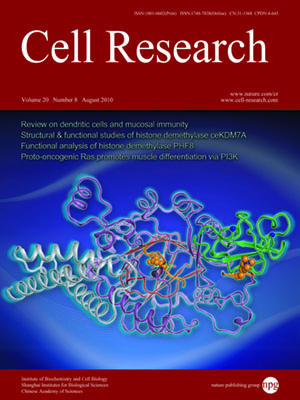
Volume 20, No 8, Aug 2010
ISSN: 1001-0602
EISSN: 1748-7838 2018
impact factor 17.848*
(Clarivate Analytics, 2019)
Volume 20 Issue 8, August 2010: 919-934
ORIGINAL ARTICLES
Proto-oncogenic H-Ras, K-Ras, and N-Ras are involved in muscle differentiation via phosphatidylinositol 3-kinase
Jisun Lee1, Kyu Jin Choi2, Min Jin Lim1, Feng Hong1, Tae Gyu Choi1, Eunyoung Tak1, Seonmin Lee1, Young-Joo Kim3, Sung Goo Chang4, Jin Man Cho5, Joohun Ha1 and Sung Soo Kim1
1Department of Biochemistry and Molecular Biology (BK21 project), Medical Research Center for Bioreaction to Reactive Oxygen Species and Biomedical Science Institute, School of Medicine, Kyung Hee University, Seoul 130-701, Korea
2Division of Radiation Effect, Korea Institute of Radiological and Medical Sciences, Seoul 139-706, Korea
3Department of Urology, College of Medicine, Cheju National University, Cheju 690-756, Korea
4Department of Urology, School of Medicine, Kyung Hee University, Seoul 130-701, Korea
5Cardiovascular Center, East West Neomedical Center, Kyung Hee University, Seoul 134-090, Korea
Correspondence: Sung Soo Kim,(sgskim@khu.ac.kr)
Oncogenic H-Ras G12V and its variants have been shown to inhibit muscle differentiation. However, the role of proto-oncogenic Ras (c-Ras) in muscle differentiation remains unclear. The active GTP-bound form of Ras has been known to associate with diverse effectors including Raf, phosphatidylinositol 3-kinase (PI3K), Ral-GDS, and other molecules to transmit downstream signals. We hypothesize that c-Ras may stimulate muscle differentiation by selectively activating PI3K, an important mediator for muscle differentiation. In our experiments, inhibition of c-Ras by farnesyltransferase inhibitors and a dominant negative form of H-Ras (Ras S17N) suppressed muscle differentiation. Consistently, individual knockdown of H-Ras, K-Ras, and N-Ras by siRNAs all blocked muscle differentiation. Interestingly, we found that c-Ras preferentially interacts with PI3K rather than its major binding partner c-Raf, during myogenic differentiation, with total c-Ras activity remaining unchanged. PI3K and its downstream myogenic pathway, the Nox2/NF-κB/inducible nitric oxide synthase (iNOS) pathway, were found to be suppressed by inhibition of c-Ras activity during differentiation. Furthermore, expression of a constitutively active form of PI3K completely rescued the differentiation block and reactivated the Nox2/NF-κB/iNOS pathway in c-Ras-inhibited cells. On the basis of our results, we conclude that contrary to oncogenic Ras, proto-oncogenic H-Ras, K-Ras, and N-Ras are directly involved in the promotion of muscle differentiation via PI3K and its downstream signaling pathways. In addition, PI3K pathway activation is associated with a concurrent suppression of the otherwise predominantly activated Raf/Mek/Erk pathway.
Cell Research (2010) 20:919-934. doi: 10.1038/cr.2010.92; published online 6 July 2010
FULL TEXT | PDF
Browse 2346


